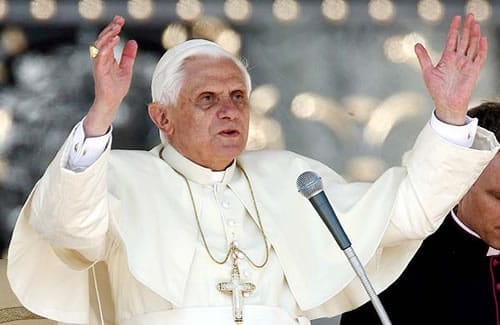On this occassion, the Pontiff greeted, at first, the faithful, who were gathered inside the Vatican basilica. The Pope discussed his last catechesis on the holy bishop and pointed out that his interior struggle,” has made him one of the greatest converts in Christian history.”
Confessions
In this regard, the Pontiff openly expressed his desire “to make visible my personal recognition in relation to a figure with whom I feel a very strong bond by the role that he had in my life of a theologian, priest and bishop.
The Holy Father showed that the interior struggle of the Saint can be seen in the Confession: “Whoever wants to bring oneself near to this extraordinary and facinating book, a book well read even today, realizes easily that Augustine’s conversion was not instantaneous nor complete from the beginning, but can be better defined as an authentic journey, that became a model for each one of us.
The path of Augustine’s conversion—he added— humbly continued until the end of his life, that it can truly be said that its diverse stages, of which three can be distinguished, belong to one unique great conversion.”
Benedict XVI described Saint Augustine as “a great searcher of truth from the beginning and throughout his life.” From this, “ the first stage of his journey of conversion was realized precisely in the progressive movement towards Christianity.” The Pope reminded that Augustine had been educated in the faith by his mother Saint Monica, and eventhough he lived a disorderly youth, “ he always marked a profound attraction to Christ.”
"Even Philosophy, especially platonism, that showed the existence of the Logos, had contributed to bring him subsequently nearer to Christ,” the Pope explained; but “ only the reading of the letters of Saint Paul, revealed to him the truth, in the faith of the Catholic Church.”
Take up and read
This was an experience, he added, that Saint Augustine recalls in the Confessions: when having withdrawn in his garden, he hears a voice of an infant that repeats: "tolle, lege, tolle, lege" (“take up and read, take up and read”); and when he took the Scriptures, he found himself with the passage of Saint Paul that exhorts him to abandon the works of the flesh and to vest himself of Christ (Rm 13: 13-14). The Pontiff explained: “He had understood that that Word at that moment was addressed to him… thus it has desolved the shadows of doubt and he finally found himself free to give himself completely to Christ.”
“The faith in Christ” – he continued-“ made him understand that God, who was seemingly so far, in reality, He was not . . . Only a God who has made Himself tangible, one like us, was finally a God to whom one can pray, for whom and with whom one could live."
The Pope explains, nevertheless, that his journey did not end in his baptism during the Paschal vigil.
Africa
Since he wanted to fulfill the dream of his life, he went back to Africa where he founded a small monastery to dedicate himself to contemplation and study.
As the Pontiff explained, this was “a beautiful dream that lasted for three years until, despite his resistance, he was consacrated priest in Hippo and destined to serve the faithful, continuously living with Christ and for Christ, but at the service of everyone.” And eventhough this was difficult, “ he understood from the very beginning that only in living for others, and not only in personal contemplation, that one could trully live with Christ and for Christ.”
In this way, the Saint learned “ to communicate his faith to simple people and to live this way for them, with tireless and unwaviringng dedication.”
Third Conversion
Benedict XVI indicated then the last stage of the Augustinian journey, his third conversion: This is the conversion that he carried everyday of his life to ask forgiveness from God.” Augustine used to believe that once baptized, as the Pope explained, in the life of communion with Christ, in the Sacraments, in the celebration of the Eucharist, he would have reached the life as described in the Sermon on the Mount.
Nevertheless, the Saint, as he advanced in age, explained that “only Christ Himself realizes truly and completely the Sermon on the Mount. We always need to be cleansed by Christ, who washes our feet, and to be renewed by Him. We need this humility that recognizes that we are sinners who are in journey until the Lord gives us definitively his hand and brings us to eternal life,” explained the Pope.
“Having been converted to Christ” – continued the Pontiff – “ who is the truth and love, Augustine followed Him for the rest of his life and has become a model for every human being, for all of us who search for God.”
Pavia
The Pontiff explained finally that it is for this reason that he wanted to end his pilgrimage in Pavia on April 27, 2007, and to present once again to the Church and to the world, in front of the tomb of this great beloved of God, his first encyclical, entitled Deus Caritas est. "This, in effect, owes much, most especially in its first part, to the thought of Saint Augustine.”
“Today also, as in his time, humanity needs to know and most especially to live this fundamental reality: God is love and the encounter with Him is the only response to the restlessnes of the human heart,” the Pope concluded.
“Let us pray, therefore, so that in our life, we may follow everyday the example of this great convert, and find, like him, in every moment of our life, the Lord Jesus, the only one who can save, purify and give us the true joy and life,” he said finally.


